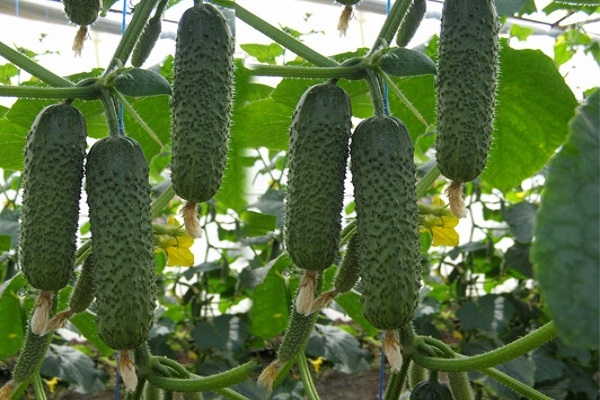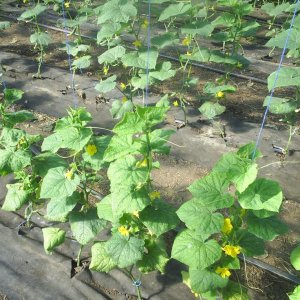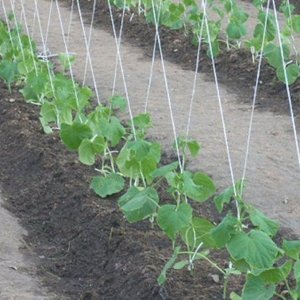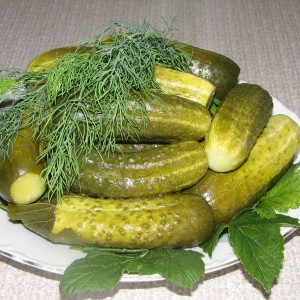How to properly grow an "Artist" cucumber: care rules for getting a bountiful harvest
Cucumber Artist F1 is a popular ultra-early hybrid, so even the most impatient summer residents are happy with it. The culture belongs to the parthenocarpic type, that is, the fruits are tied without insect pollination.
The cultivation technology of such cucumbers is no different from the agricultural technology of other varieties that need pollination by bees. The hybrid grows successfully both in greenhouses and in the open field.
The content of the article
Description
Artist f1 was brought out by Dutch breeders. Scientists have combined the early ripening period and independent fruit setting in vegetable culture, for which this hybrid is loved by gardeners. It appeared in the Russian State Register of Vegetable Crops in 2010.
Distinctive features
Cucumbers are distinguished by a peel covered with large frequent pimples.
The hybrid is indeterminate, or unlimited in growth. Therefore, the bushes must be tied up and shaped.
Composition, properties, benefits, calories
Nutritional value per 100 g:
- proteins - 0.9 g;
- carbohydrates - 2.7 g;
- fats - 0.1 g;
- fiber - 0.7 g;
- a small amount of vitamins C, PP, E and group B;
- 95-98% water, which quenches thirst and cleanses the body of toxic substances.
The total calorie content of fresh cucumbers per 100 g is only 16 kcal.
Cucumber juice has amazing properties. Thanks to the natural organic acid in its composition, it:
- removes salts from organs and joints;
- improves metabolism;
- washes away free radicals;
- expands capillaries and normalizes blood pressure;
- removes cholesterol plaques from blood vessels;
- dissolves sand and kidney stones;
- improves the properties and composition of blood.
Cucumbers are a refreshing and nutritious vitamin supplement and a versatile addition to any diet.
Specifications
The artist is a tall plant of medium branching. The flowers are female. The leaves are large, dark green. The shape of the cucumber is cylindrical, small in size (12 cm). The mass of one fruit is about 100 g. The pulp is crispy and aromatic, without bitterness.
The fruits ripen in a short time. Zelentsy is removed within 35-40 days after planting. Subject to the rules of agricultural technology from 1 sq. m planting culture gives up to 9 kg of delicious vegetables.
How to grow yourself
The Artist can be landed in two ways. At first in advance grow seedlings, and then transplant it into open ground. In the second, the seed is sown directly to the garden bed. With the seedling method, seeds are sown in April. For this, peat cups or special cassettes are used.
Direct sowing of seeds into the ground
Sowing is done when the soil warms up to + 15 ° C. The air temperature during the day should be kept at least + 22 ° C. The seeds are buried in the soil with their "spout" down to a depth of 2-3 cm and at a distance of about 10 cm from each other, then watered abundantly.
The bed is covered with agrofibre or foil so that the nighttime drop in temperature does not ruin the seedlings. The first shoots appear within 5-8 days.
Seedling method
Sowing seeds for seedlings begins with the onset of April, in some regions - at the end of March. First of all, a container and soil are prepared for the plants.
To prepare a land mixture, use the following components:
- humus - 2 parts;

- peat - 2 parts;
- sawdust - 1 part.
All this is mixed and fertilizers are added at the rate of 40 g of wood ash and 30 g of "Nitrofoski" per 10 liters of the mixture.
The containers are filled with prepared soil and 1-2 seeds are embedded in each to a depth of 1-2 cm. The optimum daytime temperature for seedlings is no more than + 25 ° C, and the nighttime temperature is no less than + 15 ° C. The soil is watered as it dries. After a month, 3-4 real leaves appear at the seedlings, which means that it is ready to go into open ground or to a greenhouse.
On a note. It is not at all difficult to grow an Artist hybrid outdoors. The main thing is to follow the basic agronomic rules. Seed material is not pretreated or soaked. The implementation of the necessary measures is to prepare the soil and place for the culture.
The plant actively grows and bears fruit in light and fertile soil. Organic fertilizer is applied before planting in open ground. An important role is played by the proximity of plants, which have a beneficial effect on the growth and development of cucumbers.
Useful neighbors for culture:
- garlic;
- dill;
- legumes;
- corn;
- onion;
- eggplant;
- beet;
- cabbage;
- salad.
Cucumbers are not planted next to tomatoes, radishes and radishes.
It is advisable not to grow the culture from year to year in the same place. Experienced vegetable growers change the garden every time, and the place for its location is sunny and without drafts.
Step-by-step cultivation and care
Cucumber Care Artist is as follows:
- After watering, the soil is loosened and at the same time weeds are removed. At the same time, care is taken not to touch the root system of cucumbers, which is located close to the soil surface.
- Since the hybrid is tall and branched, it is tied up. This helps aerate the bushes and prevents branches from tangling and fungal infections.

- A short-term drought is not terrible for cucumbers, but they are not watered with cold water. Plants are moistened directly at the roots, while using settled warm water.
- In the process of cultivating cucumbers, about 5 dressings are carried out. When growing a crop at a permanent place of growth, the first fertilizer is applied with the appearance of full-fledged leaves. To do this, use the same composition as for seedlings. Then organic and mineral fertilizers alternate. Also, the plant is fed with ash or mullein. Complex means for these purposes: "Nitroammofoska", "Plantafol", "Azofoska".
- The plant is formed into one stem, while the lateral branches are pinched at a height of 0.5 m, and the main stem - by 2 m. Thus, the growth and fruit formation of the culture are controlled.
Important! Plants are often watered, but with a small amount of water, since excessive soil moisture causes rotting of the root system.
Features of cultivation and possible difficulties
The agrotechnics of growing cucumbers Artist as a whole does not differ significantly from caring for other hybrids.
The plant grows well and gives a bountiful harvest when grown both outdoors and in greenhouse conditions. This allows you to breed a hybrid in all regions of Russia.
On a note. In some cities, monuments to cucumbers were erected (Lukhovtsy, Nizhyn). And annually on July 27, vegetable growers celebrate International Cucumber Day.
Diseases and pests
The bushes do not get sick with the usual mosaic virus and cladosporiosis. Also, the culture is resistant to powdery mildew.
But the plant is attacked by pests:
- spider mite;
- bear;
- slugs;
- thrips;
- cucumber gnats;
- melon aphid.
A spider mite is identified by a small cobweb on the back of the leaves. This pest drinks juice from plants. If it is not destroyed in time, culture will perish. To fight the tick, the plants are sprayed with Fitoverm, and the site is populated with phytoseiulus - it eats the eggs of the ticks.
Medvedki are large insects that gnaw on roots and stems... They are taken out with the preparations "Vofatox", "Medvetox".
Slugs appear in wet and neglected areas. They are harvested by hand or sprinkled with wood ash.
Thrips are able to survive the winter, being in the remains of vegetation. They suck the juices out of plants.In order to combat parasites in the fall, they carefully collect and burn all the tops, then dig up the soil. After that, the soil is watered with "Karbofos" solution.
The melon aphid has an oval body up to 2 mm long. It sits and lays eggs on the back of the leaves. In one vegetative period, up to 20 generations of aphids grow. The pest is able to destroy plants in a short time. If the aphids have spread a little, the leaves and stems are doused with a good pressure of water from a hose or washed with soapy water (200 g of laundry soap per 10 liters of water).
When there are a lot of parasites, "Aktofit" is used (80 ml per 10 liters of water), for stickiness, "Liposam" is added to the solution and the reverse side of the leaves is treated with it.
Also in April, especially in greenhouse conditions, cucumber mosquitoes attack the plants. Females lay up to 3000 eggs at a time. And when the larvae hatch, they crawl into the roots and stems. To combat mosquitoes, plantings are sprayed with Iskra (1 tablet is dissolved in 10 liters of water). This composition is enough to process 1 weave of plantings.
Harvesting and application of the crop
For a hybrid, it is important that the fruits are harvested on time. If this rule is not followed, the yield of the plant will decrease.
Cucumbers are harvested early in the morning, every other day in cool weather, and every day when it is hot, then the harvest will increase. The harvested vegetables are immediately put into the refrigerator; they are not placed in closed bags.
Zelentsy is used for making salads. The fruits taste great both fresh and in conservation.
Advantages and disadvantages
Advantages of the hybrid Artist f1:
- good tolerance to lack of light;
- early ripening of fruits (after 35-40 days);
- prolonged fruiting;
- lack of yellow spots on ripe fruits;
- good seed germination;
- developed root;
- plant resistance to drought;
- excellent presentation;
- universality of application;
- average susceptibility to disease;
- good transportability.
Disadvantages of the Artist:
- high demands on fertilizers;
- relatively low yield.
Read also:
The best recipes for pickled cucumbers with basil for the winter.
Why does gray rot appear on cucumbers and how to deal with it.
Reviews
Experienced vegetable growers evaluate the Artist hybrid mainly from a positive side. Cucumbers are actively grown in the vast majority of regions of the country. The opinions of some gardeners are further.
Anastasia, Volgograd: «Neighbors at the dacha advised cucumbers Artist F1. The variety, of course, is not that new, but last year I decided to try to grow it. I really liked the fast fruiting. The crop has grown exactly like in the photo of the package. Recomend for everybody! The fruits are both for selection - almost the same size, looking at them, you just want to start them for salting... The cucumbers taste sweet, without bitterness, although sometimes it was not possible to water on time. The pulp is firm and firm, salted well, remains crispy and without voids. True, the fruits are very prickly, I did the cleaning with gloves. "
Dmitry, Voronezh: «I mainly grow Dutch parthenocarpic cucumbers for sale in a greenhouse. I give preference to Merengue, Herman and Artist. To obtain a bountiful harvest, I form bushes on a trellis into one stem, blind up to 4-5 leaves - I remove unblown buds and stepchildren from the axils, this contributes to better formation of the root system, and the plant becomes strong and actively bears fruit. In the next 2-3 nodes, I leave one ovary, and up to 10 leaves - no more than 2 ovaries, I remove all the shoots and antennae. "
Ekaterina, Rostov: «My husband and I have been growing cucumbers for many years in a row. That year we bought the seeds of the Artist for trial. Quite expensive, like most of the imported ones, but almost all went up. They sowed them in open ground without preliminary preparation. The bed was not covered with anything (fortunately, the weather allowed). The cucumbers were allowed to grow horizontally "spread out". A little more than a month has passed, and a full harvest has already ripened.The cucumbers are small, deliciously crispy. Almost the entire harvest went to harvesting. Salted a whole keg and marinated about 20 liters. This turned out to be too much for our family, they treated all the neighbors. I really liked the artist, now I advise everyone. "
Conclusion
The ultra-early hybrid Artist F1 allows you to harvest delicious crunchy fruits already 40 days after germination. They tolerate transportation very well. Fresh cucumbers are included in the diet for those who want to lose weight. The Artist is no less good in a canned version.
The hybrid is resistant to drought and lack of light, bears fruit for a long time and ripens quickly. The artist has proven himself well among experienced vegetable growers.